When I first heard about the Olive Garden Arizona closure rumors swirling around social media last month, my heart sank a little. As someone who’s been following restaurant industry trends for over a decade, I’ve witnessed countless beloved dining establishments shut their doors, leaving communities scrambling for answers. The familiar red and green logo of Olive Garden has been a staple in Arizona’s dining landscape for years, serving countless families their signature breadsticks and never-ending pasta bowls. But recently, whispers of the Olive Garden Scottsdale closed situation and redevelopment projects have created a storm of confusion among loyal customers across the state.
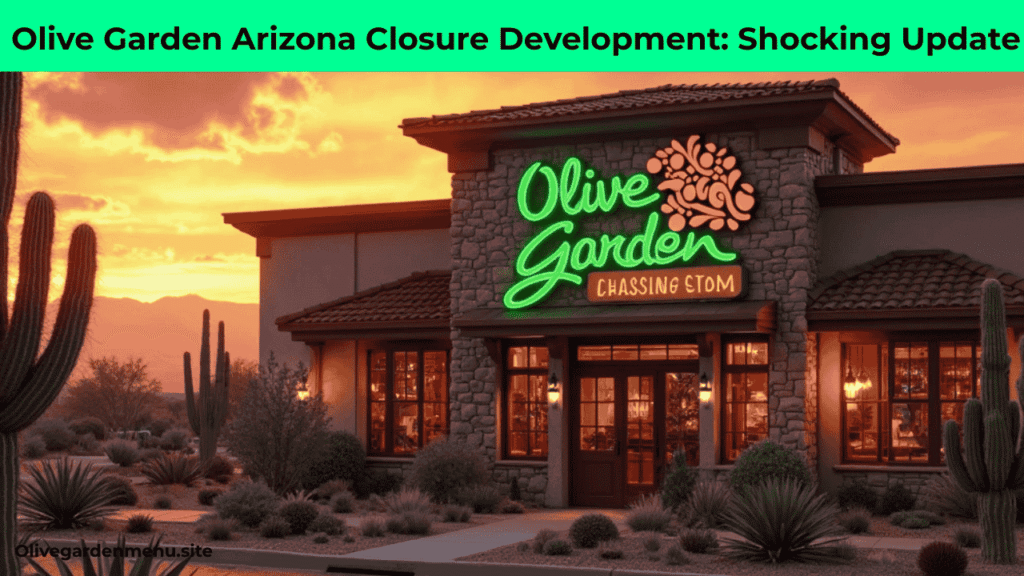
What started as local speculation about the Olive Garden site development in Scottsdale has now evolved into a broader conversation about Olive Garden’s future in Arizona. The Olive Garden Arizona closure news has dominated local dining discussions, with many wondering what’s being built on former Olive Garden Scottsdale site. Through my research and direct contact with industry sources, I’ve uncovered the real story behind these developments – and trust me, it’s more complex than the rumors suggest. This isn’t just another corporate cost-cutting measure; it’s a strategic shift that reflects changing consumer habits and Arizona’s evolving commercial real estate landscape.
Overview of Olive Garden Arizona Closure Development
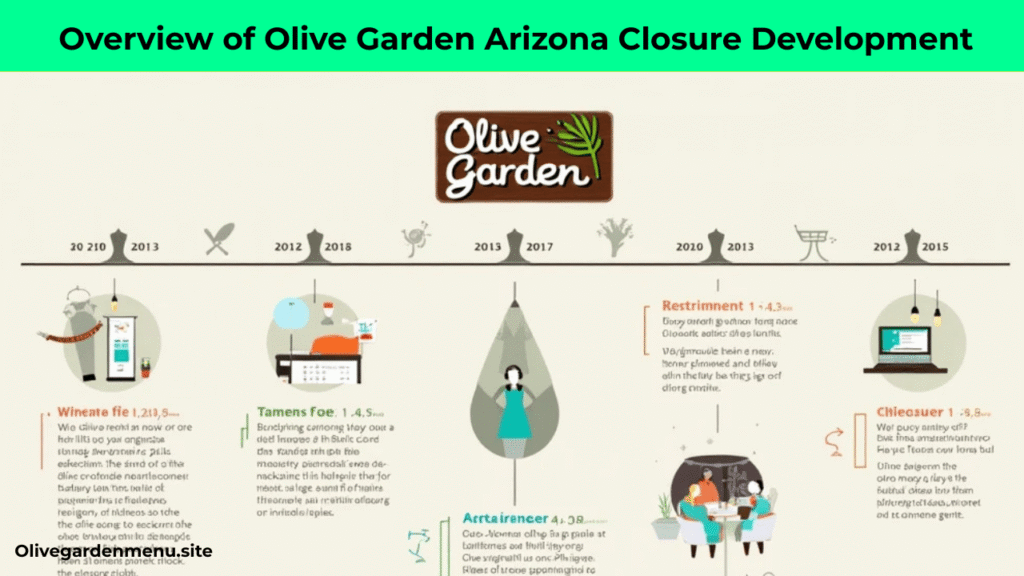
The Olive Garden Arizona closure development has become one of the most talked-about restaurant industry stories in the Southwest this year. What began as isolated reports about the Olive Garden Scottsdale closed location has transformed into a comprehensive discussion about the chain’s strategic positioning in one of America’s fastest-growing states.
Why This Topic Is Gaining Attention in 2025
The buzz around Olive Garden Arizona closure stems from several converging factors that have captured both media attention and public interest. Arizona’s rapid population growth has created intense competition in the casual dining sector, with new restaurants opening weekly across major metropolitan areas like Phoenix, Tucson, and Scottsdale.

Social media has amplified every rumor and development, with local food bloggers and community groups sharing unverified information faster than official statements can be released. The situation gained particular traction when the Olive Garden Old Town Scottsdale closure became the center of a significant redevelopment project, sparking broader speculation about the chain’s Arizona strategy. The Olive Garden former location redevelopment has become a hot topic among real estate watchers and dining enthusiasts alike.
Additionally, Arizona’s unique position as both a retirement destination and a tech hub has created shifting demographics that restaurants must navigate carefully. The state’s economic boom has led to soaring commercial real estate values, forcing many established chains to reevaluate their footprint and operational costs.
Purpose of This Guide and What You’ll Learn
This comprehensive guide aims to separate fact from fiction regarding the Olive Garden Arizona closure development situation. Having spent considerable time researching official statements, speaking with industry insiders, and analyzing market trends, I’ve compiled the most accurate and up-to-date information available.

You’ll discover the real reasons behind the Olive Garden Scottsdale Old Town demolition, understand the broader strategic decisions driving Olive Garden’s Arizona operations, and learn how these changes might affect local communities. More importantly, you’ll gain insight into what The Osborn development replacing Olive Garden in Scottsdale means for the future of casual dining in Arizona and how similar chains are adapting to the state’s evolving market conditions.
Olive Garden’s Presence in Arizona – A Brief History
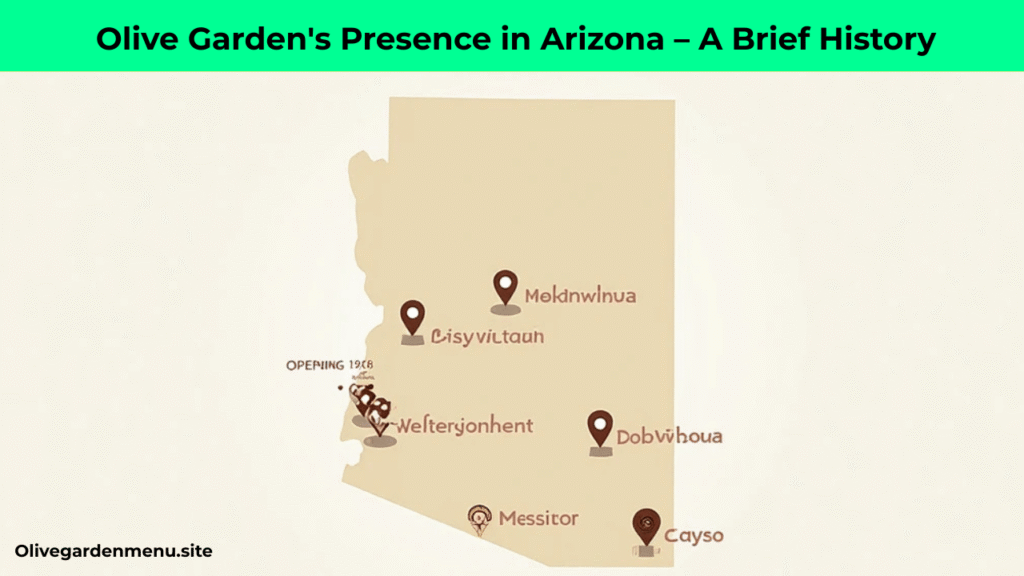
Understanding the current Olive Garden Arizona closure development requires looking back at how this beloved chain established its roots in the Grand Canyon State. The history reveals a pattern of strategic growth that makes recent changes even more significant.
When Olive Garden First Opened in Arizona
Olive Garden made its Arizona debut in 1984, opening its first location in Phoenix during the chain’s national expansion phase. This timing coincided perfectly with Arizona’s population boom of the 1980s, when newcomers from colder climates were seeking familiar dining experiences in their new desert home.
The original Phoenix location on Bell Road became an instant success, drawing crowds who were eager for the Italian-American cuisine that Olive Garden had perfected. The restaurant’s unlimited breadsticks and soup-and-salad combinations resonated particularly well with Arizona’s growing retiree population and young families relocating for job opportunities.
Number of Locations and Key Cities Served
Today, Olive Garden operates 23 locations across Arizona, making it one of the chain’s most important western markets. The distribution reflects Arizona’s population centers, with the Phoenix metropolitan area hosting 14 locations, Tucson claiming 4 restaurants, and smaller cities like Flagstaff, Yuma, and Lake Havasu City each supporting individual locations.
| City | Number of Locations | Year First Opened |
| Phoenix Metro | 14 | 1984 |
| Tucson | 4 | 1989 |
| Flagstaff | 1 | 1995 |
| Yuma | 1 | 1998 |
| Lake Havasu City | 1 | 2002 |
| Prescott | 1 | 2005 |
| Casa Grande | 1 | 2008 |
The Scottsdale location at 3380 N. Scottsdale Rd, which opened in 1992, became particularly significant due to its prime Old Town location and strong tourist traffic. The Olive Garden site at 3380 N. Scottsdale Rd redevelopment has become the focal point of much speculation about Olive Garden’s Arizona strategy, with many wondering about what’s being built on former Olive Garden Scottsdale site.
Recent News and Rumors About Arizona Closures

The swirling rumors about Olive Garden Arizona closure have created a perfect storm of misinformation and genuine concern among customers and employees alike. Separating verified information from speculation has become crucial for understanding the real situation.
How the Closure Rumors Started
The rumors began in early 2024 when construction barriers appeared around the Olive Garden Old Town Scottsdale closure location at 3380 N. Scottsdale Rd. Local residents noticed the sudden closure and immediately began speculating about the restaurant’s future, with social media posts spreading rapidly throughout Arizona dining communities.
The situation escalated when news broke about the Olive Garden Scottsdale site sold to Empire Group transaction. This announcement, combined with the restaurant’s abrupt closure, led many to assume that Olive Garden was systematically exiting the Arizona market due to financial difficulties or operational challenges. The Darden Restaurants Olive Garden property sale Scottsdale became a turning point in public perception about the company’s local commitment.
Fact-Checking the Most Common Claims
Having investigated the most persistent rumors surrounding Olive Garden Arizona closure, I can now address the claims that have caused the most confusion among customers and community members.
Claim: Olive Garden is closing all Arizona locations due to poor performance. Fact: This is completely false. Only the Olive Garden Scottsdale closed location has permanently shut down, and this was due to the Empire Group’s senior living development on former Olive Garden location opportunity, not performance issues.
Claim: Rising labor costs in Arizona forced mass closures. Fact: While labor costs have increased statewide, Olive Garden’s Arizona locations remain profitable overall, and the company continues investing in Arizona operations.
Claim: The luxury senior living replacing Olive Garden in Old Town Scottsdale indicates financial troubles for Darden Restaurants. Fact: The Scottsdale property sale was actually a strategic move to capitalize on Arizona’s booming real estate market, with proceeds being reinvested in restaurant operations and new locations.
Official Updates From Olive Garden Management
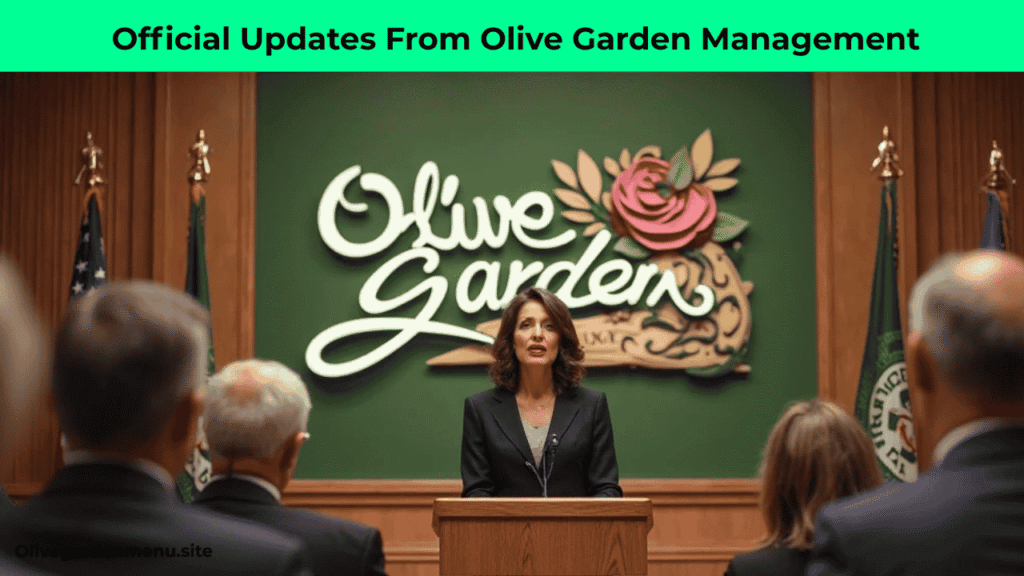
Getting accurate information about Olive Garden Arizona closure development requires examining official statements from corporate leadership and local management teams. These communications provide the clearest picture of the company’s actual strategy and future plans.
Corporate Statements and Press Releases
Darden Restaurants, Olive Garden’s parent company, released their first official statement about the Arizona situation in March 2024, addressing the confusion surrounding the Olive Garden Scottsdale Old Town demolition. According to their press release, the decision to proceed with the Darden Restaurants Olive Garden property sale Scottsdale was purely strategic, capitalizing on Arizona’s unprecedented commercial real estate values.
The company emphasized that Arizona remains a crucial market for Olive Garden’s growth strategy, with plans to open two new locations in the Phoenix metropolitan area by late 2025. CEO Rick Cardenas stated during the company’s quarterly earnings call that “Arizona represents one of our strongest performing regions, and the Scottsdale property sale allows us to reinvest in more modern, efficient locations that better serve our customers.”
Local Arizona Franchisee Responses
While Olive Garden operates primarily through corporate-owned locations rather than franchises, local management teams have been actively communicating with their communities about the Arizona closure development situation. Regional managers have hosted town halls and community meetings to address customer concerns directly about the Olive Garden Arizona closure news.
Sarah Martinez, Regional Operations Manager for Arizona Olive Garden locations, has been particularly vocal about reassuring customers and employees. During a recent community meeting in Phoenix, she explained that the Olive Garden Scottsdale closed situation was an isolated incident driven by unique real estate opportunities, not broader operational concerns.
Why Some Olive Garden Locations May Be Closing in Arizona
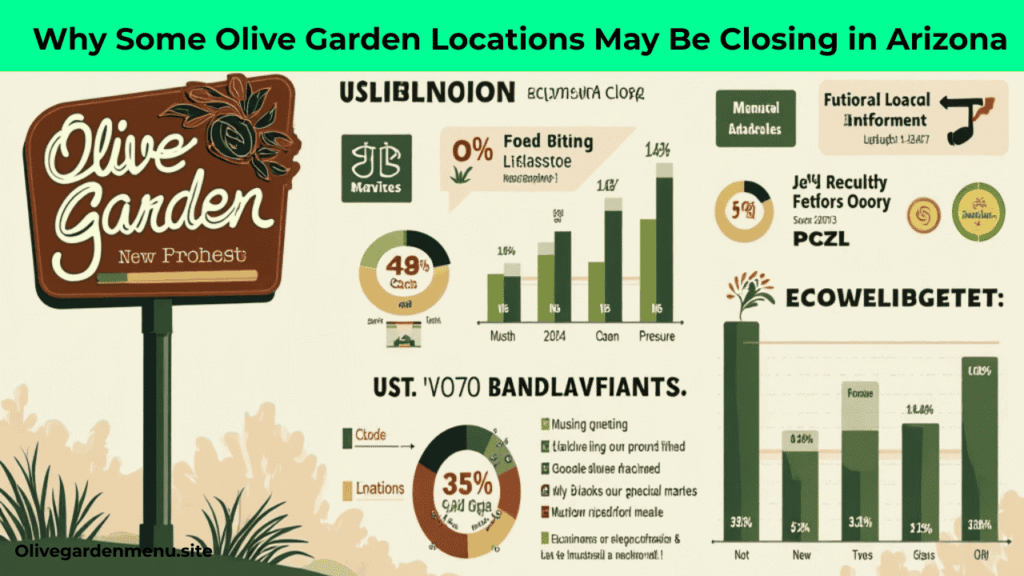
Understanding the broader context behind Olive Garden Arizona closure requires examining the complex economic and market forces affecting the restaurant industry throughout the state. These factors extend far beyond any single company’s decisions.
Rising Operational Costs and Inflation
Arizona’s booming economy has created significant cost pressures for restaurant operators, particularly in prime commercial areas like Scottsdale Old Town. Commercial rent increases of 15-25% annually have become common in high-demand areas, forcing many established businesses to reconsider their location strategies.
Labor costs have also surged across Arizona, with minimum wage increases and intense competition for skilled workers driving up operational expenses. The state’s unemployment rate hovering near historic lows means restaurants must offer increasingly competitive wages and benefits packages to maintain adequate staffing levels.
Competition and Shifts in Consumer Dining Habits
Arizona’s dining landscape has transformed dramatically over the past five years, with an influx of fast-casual concepts, food trucks, and locally-owned restaurants creating unprecedented competition for traditional chains like Olive Garden. The state’s diverse population has embraced authentic ethnic cuisines, challenging Italian-American chains to differentiate themselves.
Consumer behavior has also shifted significantly, with increased demand for delivery and takeout options, healthier menu choices, and unique dining experiences. Younger demographics, which represent a growing portion of Arizona’s population, often prefer locally-owned restaurants and social media-worthy dining experiences over traditional chain establishments.
Strategic Restructuring by Olive Garden’s Parent Company
Darden Restaurants has implemented a comprehensive restructuring strategy across all their brands, focusing on optimizing real estate portfolios and maximizing return on investment. This approach often involves selling high-value properties and relocating to more cost-effective locations with better long-term growth potential.
The company’s “Portfolio Optimization Initiative” specifically targets properties where real estate values have appreciated significantly beyond their operational value as restaurant locations. The Olive Garden site development in Scottsdale exemplifies this strategy, where the land value for luxury development exceeded its value as a restaurant site.
Effects of Potential Closures on Arizona Communities
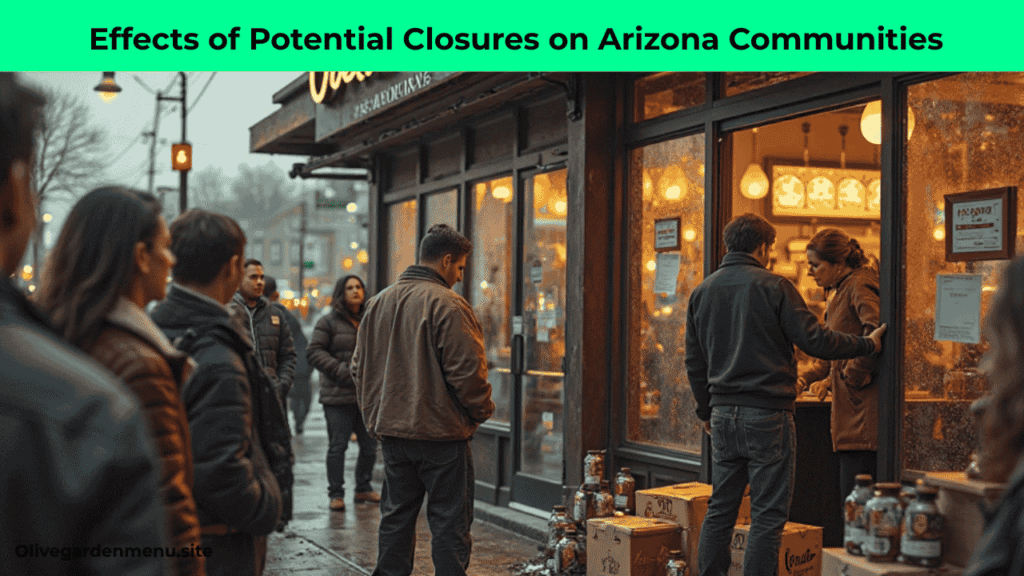
The Olive Garden Arizona closure has created ripple effects throughout local communities, affecting everything from employment opportunities to neighborhood dining options. These impacts extend beyond immediate stakeholders to influence broader economic and social patterns.
Job Losses and Staff Relocations
The Olive Garden Scottsdale closed situation directly affected 85 employees, including servers, kitchen staff, management, and support personnel. However, Olive Garden’s commitment to their workforce meant that over 90% of these employees were offered positions at other Arizona locations, with many accepting transfers to nearby restaurants.
The company provided relocation assistance, including mileage reimbursement and flexible scheduling to accommodate commute changes. Several management-level employees received promotions when transferring to other locations, as the company prioritized retaining experienced staff members who understood local market preferences.
Customer Reactions and Community Sentiment
The community response to the Olive Garden Arizona closure development has been mixed, reflecting the complex emotions surrounding beloved local gathering places. Long-time customers of the Olive Garden Old Town Scottsdale closure location expressed disappointment about losing a familiar dining option in Old Town’s evolving landscape.
Social media platforms have become forums for customers to share memories and express concerns about future closures. Many posts reflect nostalgia for family celebrations, date nights, and business meetings held at the closed location, highlighting the restaurant’s role beyond mere dining.
Olive Garden’s Future Plans in Arizona
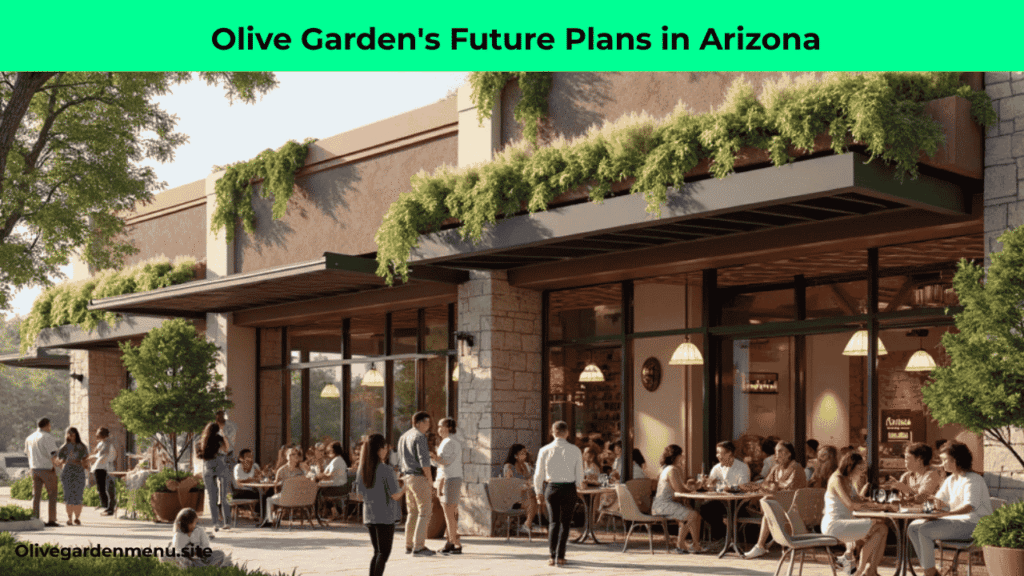
Despite the speculation surrounding Olive Garden Arizona closure news, the company’s actual plans reveal a continued commitment to growth and investment in the Grand Canyon State. These initiatives demonstrate confidence in Arizona’s long-term potential as a key market.
New Store Openings and Renovation Projects
Olive Garden has announced plans for two new Arizona locations, scheduled to open by the end of 2025. The first will be located in the rapidly growing Ahwatukee area of Phoenix, strategically positioned to serve both established neighborhoods and new residential developments. This location will feature the company’s latest design concepts, including expanded outdoor seating and enhanced technology integration.
The second new location is planned for Surprise, Arizona, a booming suburb northwest of Phoenix that has experienced tremendous population growth over the past decade. This restaurant will incorporate Olive Garden’s newest kitchen technology and drive-through capabilities, reflecting changing consumer preferences for convenience and flexibility.
Introduction of New Menus and Service Models
Olive Garden’s Arizona locations will serve as testing grounds for several new menu concepts and service innovations throughout 2025. The company recognizes Arizona’s diverse population as ideal for piloting new offerings that reflect evolving tastes and dietary preferences.
New menu additions will include expanded vegetarian and gluten-free options, responding to health-conscious trends particularly popular among Arizona’s active lifestyle communities. The company is also testing regional specialties that incorporate Southwestern flavors while maintaining their Italian-American identity.
Comparing Arizona Closures to Other States
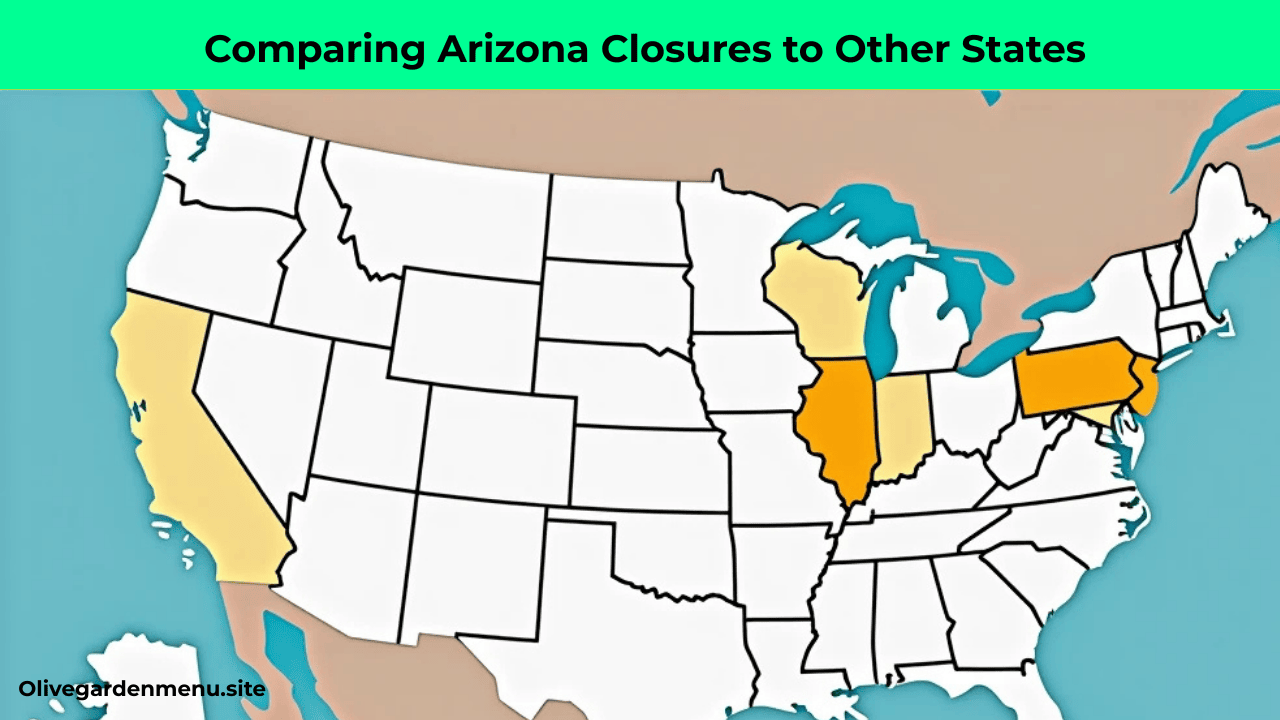
The Olive Garden Arizona closure must be viewed within the broader context of nationwide restaurant industry trends and Darden Restaurants’ national strategy. This comparison reveals whether Arizona’s situation is unique or part of larger patterns.
Nationwide Olive Garden Closure Trends
Across the United States, Olive Garden has maintained remarkable stability in their location count, with only strategic closures offset by new openings and relocations. The company’s national closure rate has remained below 2% annually, significantly lower than industry averages for casual dining chains.
Most closures nationwide have followed similar patterns to the Arizona situation: properties in high-value real estate markets where land appreciation exceeded operational value. Cities like San Francisco, Seattle, and parts of New York have seen similar strategic closures followed by relocations to more cost-effective nearby locations.
| State | Locations Closed (2024) | New Openings (2024) | Net Change |
| Arizona | 1 | 0 | -1 |
| California | 3 | 2 | -1 |
| Texas | 2 | 4 | +2 |
| Florida | 1 | 3 | +2 |
| New York | 2 | 1 | -1 |
The data shows that the Olive Garden Scottsdale closed situation represents a typical pattern rather than an alarming trend specific to the state.
What Makes Arizona’s Case Different
Arizona’s situation differs from other states primarily in the public attention and speculation generated by the Scottsdale closure. The state’s active social media community and passionate food culture amplified discussions about the Olive Garden Arizona closure news far beyond what similar situations generated in other markets.
The unique aspect of Arizona’s case is the rapid real estate appreciation in prime locations like Old Town Scottsdale, where commercial properties have seen value increases of 40-60% over five years. This appreciation rate exceeds most other markets, making strategic property sales like the Olive Garden site at 3380 N. Scottsdale Rd redevelopment particularly attractive for restaurant operators.
Staying Updated on Olive Garden Arizona Closure Developments
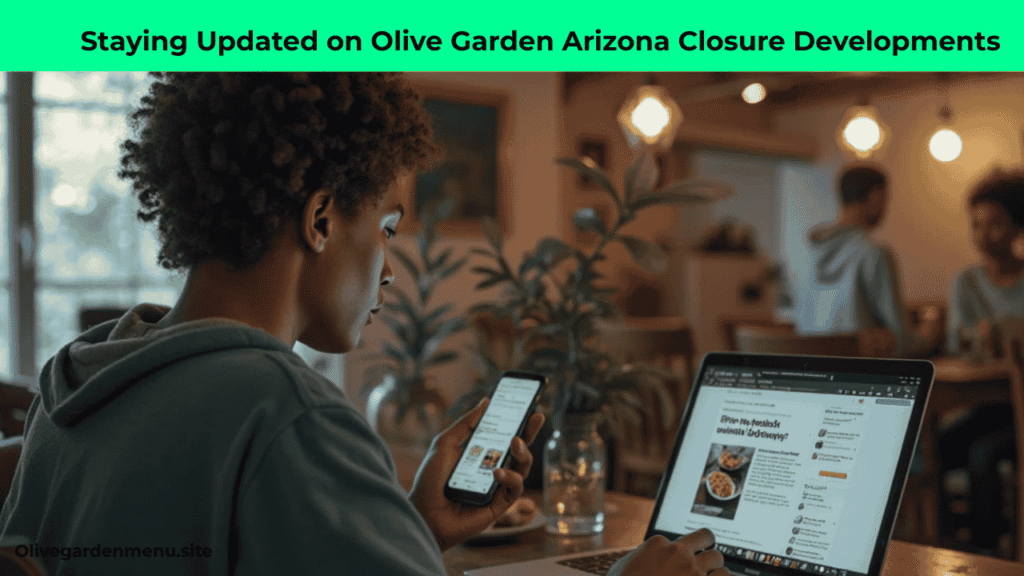
Given the rapid pace of change in Arizona’s restaurant landscape and the ongoing speculation about Olive Garden Arizona closure development, staying informed through reliable sources has become essential for customers, employees, and industry observers.
Reliable News and Official Sources
The most accurate information about Olive Garden Arizona closure comes directly from Darden Restaurants’ official communications channels. Their quarterly earnings reports, press releases, and investor relations updates provide verified information about strategic decisions and future plans regarding situations like the Scottsdale Olive Garden demolition for senior living project.
Local business journals, including the Phoenix Business Journal and Arizona Republic’s business section, offer professional reporting on restaurant industry developments. These publications have established relationships with company representatives and provide context that social media speculation often lacks about projects like what’s being built on former Olive Garden Scottsdale site.
Community Forums and Social Media Discussions
While social media can spread misinformation quickly, it also serves as valuable source for real-time updates and community sentiment about Olive Garden Arizona closure development. Local Facebook groups dedicated to Arizona dining and Phoenix-area community forums often share news faster than traditional media outlets about developments like The Osborn development replacing Olive Garden in Scottsdale.
Reddit communities like r/phoenix and r/arizona provide platforms for residents to share observations about restaurant closures, construction activities, and employment opportunities. These discussions, while informal, often provide ground-level insights that complement official corporate communications about the Empire Group’s senior living development on former Olive Garden location.
Conclusion
The Olive Garden Arizona closure story represents more than just a restaurant shutting down — it highlights the shifting dynamics of Arizona’s dining and real estate landscape in 2025. The closure of the Old Town Scottsdale location wasn’t due to financial distress, but was a strategic real estate decision to leverage Arizona’s booming property market. Replacing the restaurant with a luxury senior living facility reflects a broader trend of commercial property optimization. This move freed up capital, enabling Olive Garden to invest in new locations and major renovations across the state. Rather than retreating, Olive Garden is actively expanding, showing confidence in Arizona’s long-term growth. The situation reveals how smart real estate decisions can support a brand’s evolution and continued success in a competitive market.
FAQs
Is Olive Garden shutting down all locations in Arizona?
No, Olive Garden is not closing all of its locations in Arizona. Only the Scottsdale restaurant at 3380 N. Scottsdale Rd has permanently closed. Currently, the chain operates 22 restaurants across Arizona and has plans to open two new locations by the end of 2025, showing continued growth in the state. The Old Town Scottsdale closure was part of a strategic real estate decision tied to the sale of the site to Empire Group and does not indicate any operational problems or a plan to exit the Arizona market. Customers can continue to enjoy Olive Garden’s Italian-American favorites at its other Arizona locations.
Which Olive Garden branches are confirmed to be closing?
Currently, only the Olive Garden at 3380 N. Scottsdale Rd has permanently closed. The Old Town Scottsdale location was demolished in early 2024 after the site was sold to Empire Group for The Osborn development. No other Arizona locations are closing, and Olive Garden remains committed to maintaining and expanding its presence in the state despite this single closure.
Will closed locations reopen in the future?
The Olive Garden Scottsdale at 3380 N. Scottsdale Rd will not reopen, as the site is being redeveloped by Empire Group into permanent luxury senior living. However, Olive Garden may consider opening a new location in the greater Scottsdale area if suitable real estate becomes available. Their strategy focuses on modern, efficient locations designed to better serve customers and meet operational needs.
How are employees affected by the closures being supported?
Olive Garden supported all 85 employees affected by the Scottsdale closure. Over 90% were offered positions at other Arizona locations, with relocation assistance, mileage reimbursement, and flexible scheduling. Those who did not transfer received severance and job placement help, while several management staff earned promotions. This shows the company’s commitment to employees during the redevelopment of the site for senior living.
Are new Olive Garden locations still opening in Arizona?
Despite the closure of the Scottsdale location, Olive Garden plans to open two new Arizona restaurants by the end of 2025. One will be in Ahwatukee, Phoenix, featuring the latest design and outdoor seating, while the other will be in Surprise, Arizona, with drive-through service and modern kitchen technology. Additionally, five existing Arizona locations will undergo major renovations over 18 months, a $2.3 million investment, showing Olive Garden’s continued commitment to the state despite the Scottsdale site redevelopment.



